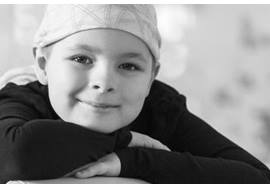Malignant Bone and Soft Tissue Tumors
Malignant tumors affect bones and soft tissues such as muscles, nerves, tendons, joint linings, blood vessels and fat in the body. Malignant tumors are cancerous. They can grow and spread (metastasize). A malignant bone or soft tissue cancer is called a sarcoma.
Age-appropriate care is important to ensure every patient, from infant to teen, receives the right care as their body grows and develops. The orthopedic oncology experts at Nationwide Children's treat malignant bone and soft tissue sarcomas, while considering each patient's short- and long-term outcomes.
Whether your child has received a diagnosis, is currently in treatment, or you are looking for a second opinion, the Ortho-Oncology team at Nationwide Children's can help. From surgery to therapy to ongoing follow-up, your team is with you every step of the way.

Nationwide Children's Hospital is ranked by U.S. News & World Report for Orthopedics.
Malignant Bone Sarcomas We Treat
Ewing sarcoma is a form of solid tumor cancer that usually starts in the bone. It typically occurs in the long bones of the legs or arms or in the pelvis, chest wall, spine or skull. It is the second most common tumor of the bone. Ewing sarcoma can also begin in the soft tissues. The lungs and other bones are the most common locations for Ewing sarcoma to spread (metastasize). These are called the Ewing family of tumors (EFTS) and include:
- Ewing sarcoma
- Atypical Ewing sarcoma
- Peripheral primitive neuroectodermal (PNET) tumor of the bone
Osteosarcomas are cancerous (malignant) tumors of the bone. They start in the cells that normally form new bone tissue (osteoblasts). These tumors are usually found near the ends of the long bones in the legs including the thigh bone (femur) and shin bone (tibia). The next most common site is the end of the thigh bone (femur) near the knee. It can also occur in other bones.
Malignant Soft Tissue Sarcomas We Treat
Soft tissue sarcomas are classified as rhabdomyosarcomas or non-rhabdomyosarcomas. Rhabdomyosarcomas form in the muscle and are the most common pediatric soft tissue sarcoma. There are over 50 types of non-rhabdomyosarcomas, which are named according to their location. For example, soft tissue sarcomas in the fat are called liposarcomas.
Rhabdomyosarcoma (RMS) is a soft-tissue cancer. It can start in muscle cells from many different areas of the body. The sarcoma grows in soft tissue such as muscle, connective tissue like tendons or cartilage, blood vessels, nerves, and joint membrane tissue. There are two common types of RMS:
- Embryonal RMS is the most common type of RMS. It most often occurs in the head and neck area, or in the genital area.
- Alveolar RMS most often occurs in the arms, legs, or trunk (chest and abdomen). This type occurs more often during the teen years.
How Are Malignant Bone and Soft Tissue Tumors or Lesions in Children Treated?
- Arthroplasty, or joint replacement surgery, may be offered for benign tumors that involve joint destruction or severe deformity. It can be considered for conditions like giant cell tumor or aggressive chondroblastoma that compromise joint function and cause significant pain. When joint replacement is needed, we also offer comprehensive arthroplasty care. Unlike centers that perform the procedure on adults only, we have significant experience reconstructing joints in children and young adults, preserving or restoring their range of motion.
- Chemotherapy
- Curettage and bone grafting: A common procedure for benign bone tumors like enchondroma, chondroblastoma, and giant cell tumor. It involves scraping out the tumor and filling the cavity with bone graft to promote healing.
- Embolization: Pre-operative procedure to reduce blood flow to highly vascular tumors like aneurysmal bone cysts, making subsequent surgical resection safer and more manageable. The choice of surgical procedure depends on various factors, including tumor type, location, size, patient's age and functional requirements, and the extent of bone and soft tissue involvement. It's essential for the surgical team to carefully assess each case and tailor the approach accordingly to achieve the best possible outcome for the patient.
- Limb salvage surgery aims to remove the tumor while preserving the limb's function and appearance. It involves techniques such as wide resection of the tumor followed by reconstruction using metal implants, bone grafts, or biological reconstruction techniques like allografts or vascularized fibula grafts. Limb salvage surgery is commonly considered for most benign bone tumors to maintain functionality and cosmesis.
- Non-invasive limb lengthening or expandable prosthetics: These implants are controlled by a magnet to lengthen the limb instead of lengthening surgically to keep up with patient's growth. Patients are typically seen in the office every two months and lengthen at least a few millimeters each time. This is a painless approach. Devices can lengthen 6 to 9 centimeters to keep up with patient's skeletal growth.
- Osteotomy: Surgical cutting of bone to correct deformities caused by benign tumors like fibrous dysplasia or osteochondroma.
- Radiation Therapy
- Resection: Surgical removal of the tumor without limb preservation, typically considered for aggressive or recurrent tumors where limb salvage is not feasible.
- Rotationplasty is often considered for cases where a significant portion of the bone needs to be removed. It involves removing a segment of bone, rotating the remaining portion (usually the foot and ankle), and reattaching it to the upper leg. This procedure can be considered for tumors near the knee joint, such as osteosarcoma, where limb salvage is challenging. Nationwide Children's performs more rotationplasty procedures than almost any other hospital. This unique operation converts what would be an above-knee amputation to the functional outcome of a below-knee amputation. This procedure can also offer activity options not available with most prosthetic knees or above-knee amputations, such as the ability to play sports that involve heavy jumping, rotating, running or pivoting.
- Targeted muscle reinnervation (TMR) is a surgical technique used to improve prosthetic control and reduce phantom limb pain in amputees. While not typically used directly for benign tumors, it can be part of the treatment plan for cases where limb amputation is necessary, such as in advanced osteosarcoma or aggressive giant cell tumor. TMR attaches those cut nerves into the muscle around the amputation. The procedure can eliminate or prevent phantom nerve pain. It also gives children the option to eventually make use of a bio-prosthetic. A bio-prosthetic is a device that connects the nerves to the prosthetic so that people can control it using their own thoughts and nerve signals, much like a normal limb. Our team pioneered TMR in children with great success after performing dozens of successful TMR procedures in adults, and now teaches the approach to surgeons from around the world. As the world’s first center performing targeted muscle reinnervation (TMR) in children, we are leading the way toward a future with less post-amputation pain and the potential for bio-prosthetics.
Why Choose Nationwide Children's to Treat My Child's Malignant Bone or Soft Tissue Tumor?
The Orthopedic Oncology Program Nationwide Children's focuses on innovative limb salvage strategies and ways to protect quality of life both now and in the future for our patients. We are supported by a robust range of related programs at to help maximize health outcomes, from oncology and child life to adaptive therapies and rehabilitation resources.
Leading the Way to New Treatments and Outcomes Through Clinical Research
Clinical care and research work together. This helps scientists and doctors to find new treatments and therapies. Clinical studies (also called clinical trials) will continue to become more common in daily care at Nationwide Children's. Clinical studies help doctors learn more about conditions and treatment.
This means you might hear about a clinical study that your child might be able to join. This does not mean that your child has to join a study. You always have the choice about whether or not to join a study.



